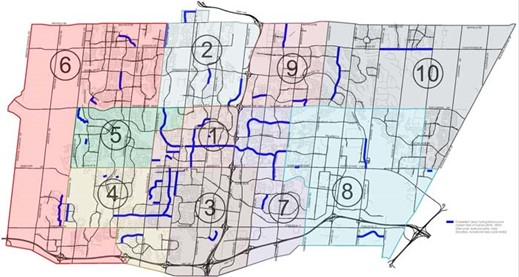In a unanimous vote at Mar 9th Committee meeting, Brampton Council said yes to the 2022 implementation schedule of the Active Transportation Master Plan. This includes $8.6 million budget for education, programs, bike lanes, pedestrian crossings, counters, initiating a bicycle friendly business program, updating the city’s cycling map, and supporting Bike the Creek signature cycling event.
The motion did not pass without debate. The installation of cycling infrastructure often creates controversy, particularly in suburban cities, like Brampton, where cycling for transportation is less common than in larger urban centres. A recent study found that most drivers don’t like sharing the road with cyclists because they believe the cyclists are inconsiderate. It turns out the vast majority of cyclists treat the road rules with respect, yet the impression lingers. Local politicians are a target of vocal opponents who don’t want to compete for road space with cyclists or who see bike lanes as taking away valuable road space that otherwise could be used for more traffic or on-street parking.
The fact is bike lanes can often improve traffic flow by defining a clear space where cyclists are supposed to be on the road. They also tend to calm traffic, reducing average speeds, making the road safer for all, but especially for vulnerable users such as pedestrians and cyclists. Safer infrastructure also encourages more pedestrian and cycling behaviour, thus reducing the number of cars on the road. As communities become more active, there are corresponding improvements in health outcomes and the sense of well-being amongst practitioners.
Despite these public benefits, the controversy remains. Residents may object to a bike lane being installed in front of their house because it would take away their on-street parking. Yet it is often the same residents who complain about high-speed drivers and who want calming measures put in place.
Quelling the controversy is possible. Communication is the key, letting residents know about the coming infrastructure, educating them about the benefits and listening to their concerns. Once the infrastructure has been in place for a few years, it becomes the norm. Strangely enough, when that happens, residents will complain bitterly if a civic leader proposes they be removed.
Brampton’s Transportation Planning and Road Engineering staff listened patiently as Council raised complaints received from constituents. They agreed to do a better job of contacting those residents to ensure their concerns were heard and addressed without compromising the integrity of the planned active transportation network. Satisfied with this approach, in the end, all 10 Councillors and the Mayor voted to support the updated implementation schedule.
by David Laing
2022 03 09 Implementation of ATMP 2021-2022 Annual Report
2022 03 09 Committee of Council ATMP 2021-2022Implementation Annual Report presentation
2022 03 09 CofC BikeBrampton delegation in support of the ATMP Annual Report by David Laing

